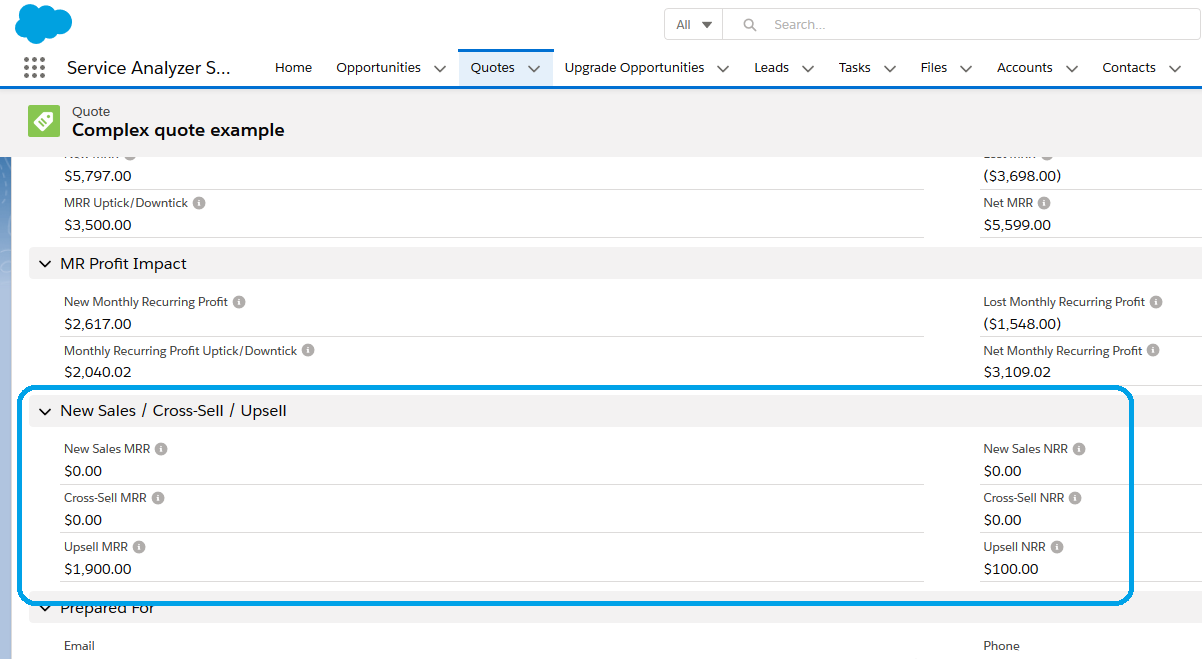Automate Upsell, Cross-Sell, and New Sales Metrics for Subscription Services in Salesforce
Upsell, Cross-Sell and New Sales are among the most important sales metrics, and are reported by virtually all businesses. Automating Upsell, Cross-Sell and New Sales metrics calculations is desirable to ensure accurate reporting as well as avoid user errors.
While these metrics are pretty straightforward for traditional “widget” sales, there are numerous considerations regarding their calculation for subscription services.
In this post, “widget sales” are “any-product, physical object” sales similar on-line shopping: a customer may place multiple orders, each with multiple items with various quantities and separate delivery dates.
The key difference between widget vs. subscription is that widget sales are transactional (in a sense that they are independent orders) while services have a life span and transactions happen during the entire life cycle of the service.
For example, a service can get ordered, upgraded (e.g., more user licenses), moved (e.g., to a different data center), renewed a few times and finally get canceled — all of this can happen over a few years’ time. In contrast, a “widget” order is typically delivered within days or weeks.
Other differences include:
- A need for separate calculations for recurring and non-recurring charges,
- Quotes and orders potentially having a mixture of line item types (e.g., new service, upgrade, re-term, etc.),
- Quotes and orders spanning multiple services.
Due to the above factors, automating Upsell, Cross-Sell and New Sales metric calculations for subscription services more complex than for traditional “widgets”.
Upsell, Cross-Sell and New Sales Metric Definitions
Before diving into intricacies of subscription service management, let’s take a look at “classic” definitions of Upsell, Cross-Sell and New Sales.
They may vary a bit depending on the source usually go along these lines:
| Metric | Definition |
|---|---|
| New Sales | Purchase of a primary product. |
| Cross Sell | Purchase of anything in conjunction with the primary product, but products are unrelated. |
| Upsell | Purchase that makes the primary product more expensive (upgrade, premium). |
New vs. Existing Account Considerations
While Upsell, Cross Sell and New Sales definitions for subscription services vary slightly from business to business, they typically depend on some form of ‘new account’ identification.
Please refer to the following post for comprehensive information on fully automated ‘New Account / Logo’ identification strategies.
Line Item Types
While in widget sales each line item is for the most part a new product request (with optional add-ons, quantity, discount, etc.), subscription service quotes & orders allow multiple line item types.
Their names vary across industries (e.g., telecommunications industry refers to them as MACDs), but typically boils down the following set:
| Line Item Type | Description |
|---|---|
| New | Purchase a brand-new service. |
| Cancel | Cancel an existing service (this is different than an order cancellation). |
| Replace | Cancel an existing service replacing it with a newly created one. |
| Re-Term | Change service term with an optional re-rate (also includes a renewal at new price and term). |
| Service Request | Service work request resulting in a non-recurring service charge only. |
Definitions Revisited
Now that we’ve covered new account definition as well as order line item types for subscriptions, we can revisit the Upsell, Cross Sell, New Sales definitions for subscription services:
| Metric | Subscription Services Definition |
|---|---|
| New Sales | Services for new logo customers (first time sale to a new account). |
| Cross Sell | New services for existing customers. |
| Upsell | Service upgrades (including replacement with a new service) and re-rates. |
| Important | The above definitions tend to be looser than their “widget” counterparts and may differ across businesses. |
Putting It All Together — A CPQ Example
Nextian allows quotes with multiple line item types, each supporting MRC (Monthly Recurring Charge) and OTC (One-Time Charge):

With the following calculations defined as sums of MR Total and NR Total on individual line items:
| Line Item Type | New Logo | Existing Business |
|---|---|---|
| New | New Sales (MRR & NRR) | Cross-Sales (MRR & NRR) |
| Replace | — | Upsell (MRR & NRR) |
| Re-Term / Re-Rate | — | Upsell (MRR & NRR) |
| Service Request * | — | Cross-Sales (NRR only) ** |
| Cancel ** | — | — |
* Service Requests have only non-recurring charges.
** Cancellations are excluded altogether from new NRR / MRR calculations (they are included in lost revenue).
| Important | Since businesses use varying definitions of New Sales, Cross-Sell and Upsell, Nextian allows changing how they are calculated. |
Sourcing Reporting Data
Widget sales (such as on-line shopping) have little distinction between quote and order.
With subscription services it’s different: a quote becomes an order that produces a service.
Nextian calculates New Sales, Cross-Sell and Upsell on quotes, and propagates numbers to opportunities via syncing quotes.
[Syncing] Quote → Opportunity
The screenshot below illustrates how this looks on an opportunity:

Since opportunities relate to orders, reporting is possible for both sales funnel (from opportunities) as well as closed-won business with subsequent changes (from orders).
Conclusions
Upsell, Cross-Sell, New Sales are one of the most important sales metrics While their “classic” definitions are fairly straightforward, for subscription services they need to be re-defined to consider transactions happening during the entire service life cycle (upgrades, changes, replacement, re-rates and others).
It is possible to implement fully automated calculations of these metrics in Salesforce with modifications of standard CRM objects (quotes, price books, etc.) or purchasing an off-the shelf CPQ package capable of quoting subscription services such as Nextian CPQ & Sales.
Nextian specializes in Quote-to-Cash (QTC) software and services for cloud and communications — including CPQ and Sales Management — helping providers accelerate growth and increase customer lifetime value.
Contact us today to find out how we can help you!






